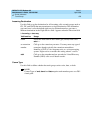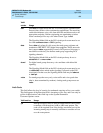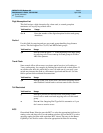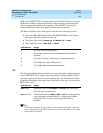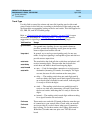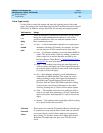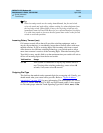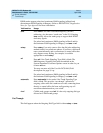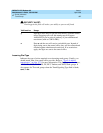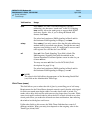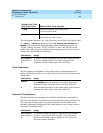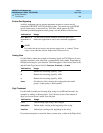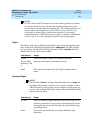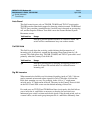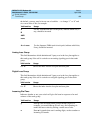
DEFINITY ECS Release 8.2
Administrator’s Guide
555-233-506
Issue 1
April 2000
Screen reference
986Trunk Group
17
DIOD trunks support pulsed and continuous E&M signaling in Brazil and
discontinuous E&M signaling in Hungary. Refer to DEFINITY ECS Application
Notes for Type Approval for more information.
Cut-Through
This field appears when the Outgoing Dial Type field is either
rotary or tone.
Valid entries Usage
tone
Enter tone to use Dual Tone Multifrequency (DTMF)
addressing, also known as “touch tone” in the U.S. Entering
tone actually allows the trunk group to support both DTMF
and rotary signals.
For pulsed and continuous E&M signaling in Brazil and for
discontinuous E&M signaling in Hungary, use
tone or mf.
rotary
Enter rotary if you only want to allow the dial pulse addressing
method used by non-touch tone phones. If you have a full touch
tone system internally and a connection to a central office that
only supports rotary dialing, for example, it would be
appropriate to enter
rotary.
mf
Enter mf if the Trunk Signaling Type field is blank. The
Multifrequency Signaling field must be enabled on the
System-Parameters Customer-Options screen in order for you
to enter
mf here.
You may not enter mf if the Used for DCS field (Field
descriptions for page 2) is
y.
For pulsed and continuous E&M signaling in Brazil and for
discontinuous E&M signaling in Hungary, use
tone or mf.
automatic
Enter automatic for tie trunks if the Trunk Signaling Type
field is blank. This provides “cut-through” operation to
outgoing callers who dial a trunk access code, connecting them
directly to central office dial tone and bypassing any toll
restrictions administered on your switch.
r1mf
CAMA trunk groups use r1mf. It is the only outgoing dial type
allowed on CAMA trunk groups.




